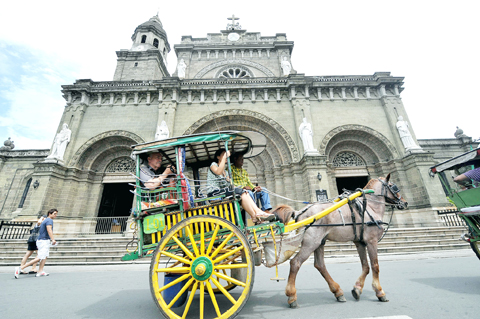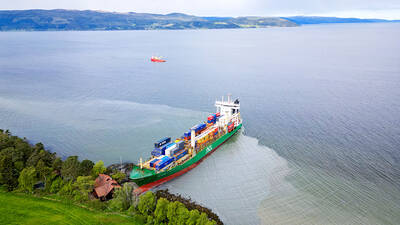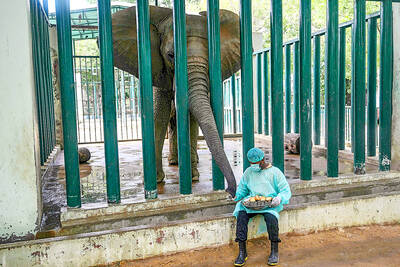In the shadows of an ancient cathedral in the Philippine capital, wilting horses attached to carriages shelter from the tropical sun as their drivers try to interest the few tourists milling around.
Hawkers exhibit sombreros, fans and rosaries on the pavement nearby but few buyers are in sight — a depressingly familiar scenario for Manila’s historic tourist district centered on the colonial Spanish walled city of Intramuros.
Tourists generally skip old Manila in their rush to Boracay and some of the nation’s other tropical islands, but the new government of Philippine President Benigno Aquino is hoping to entice them to linger a little longer.

PHOTO: AFP
“Intramuros should be the top tourist attraction in Manila,” Tourism Secretary Alberto Lim, who has been in the post since June, said in a recent interview.
“We should build museums, we have so many beautiful artefacts that are sitting in warehouses, it’s almost criminal that they’re going to waste and that they’re deteriorating,” he said.
The archipelago’s cultural history includes three centuries as a Spanish colony that ended in 1898, followed by nearly half a century under US rule.
But Manila, which was once dubbed the “Pearl of the Orient”, is now better known for its sprawling slums and widespread poverty than its architectural and cultural riches.
Much of the architecture that made it one of Asia’s most intriguing cities was destroyed during World War II, when US bombs rained down to oust the occupying Japanese forces.
Efforts by post-war architects to rebuild Manila’s ruined churches were not a success because they lacked experience and technology, said Paulo Alcazaren, architect and founder of the Heritage Conservation Society.
“The conservation during that period was pretty primitive. They tried to replicate the original stone with concrete blocks and cement,” he said.
Nevertheless, nuggets of historical gold can still be found in old Manila.
Among them is the shell of Intramuros, built by the Spanish rulers as their walled enclave and where they executed Philippine revolutionary hero Jose Rizal.
Another is the Romanesque-Byzantine Manila Cathedral, which was originally constructed in 1581 and then rebuilt six times after being destroyed by earthquakes, fires and bombing.
Nearby the Spanish-era San Augustin Cathedral is guarded at the entrance by Chinese lion statues, a legacy of the Philippines’ long history of immigrants from China.
For Carlos Celdran, whose theatrical tours of the churches and nearby Intramuros are a must-see for any visitor, tourists who skip old Manila miss an opportunity to explore a historical melting pot of cultures unique in Asia.
“Our Hispanic past is unique for the region ... for a Korean tourist a Catholic church is really exotic,” Celdran said.
When tourists do stay in the Philippine capital before hitting the island resorts, many of them end up staying in hotels in the swanky Makati area, which was built on the site of a former airport after World War II.
Makati is now Manila’s financial heart, as well as an expat-haven with designer shopping malls, international hotels, chic bars and up-market restaurants.
But Celdran said old Manila was more authentic.
“Makati will always show you what the Philippines wants to be ... glitzy, shiny, new, controlled, instead of showing you what we really are ... unbridled and gloriously chaotic,” he said.
Celdran and Alcazaren see potential for Manila’s old quarter, but believe it should be redeveloped as part of a broader project encompassing the port area of Manila Bay.
Manila Bay is renowned for its golden sunsets, which can be enjoyed over a cocktail on the terrace of the Manila Hotel, a US colonial-era building that once included the Beatles among its celebrity guests.
Celdran said Manila’s port area, with its palm-tree-lined boardwalk, had the potential to be the Philippines’ version of Miami in the US.
Yet for the time being, visitors seeking a sunset vista are more likely to encounter half-naked street children scavenging along the litter-strewn beach with a putrid smell of pollution wafting off the sea.

NO EXCUSES: Marcos said his administration was acting on voters’ demands, but an academic said the move was emotionally motivated after a poor midterm showing Philippine President Ferdinand Marcos Jr yesterday sought the resignation of all his Cabinet secretaries, in a move seen as an attempt to reset the political agenda and assert his authority over the second half of his single six-year term. The order came after the president’s allies failed to win a majority of Senate seats contested in the 12 polls on Monday last week, leaving Marcos facing a divided political and legislative landscape that could thwart his attempts to have an ally succeed him in 2028. “He’s talking to the people, trying to salvage whatever political capital he has left. I think it’s

Polish presidential candidates offered different visions of Poland and its relations with Ukraine in a televised debate ahead of next week’s run-off, which remains on a knife-edge. During a head-to-head debate lasting two hours, centrist Warsaw Mayor Rafal Trzaskowski, from Polish Prime Minister Donald Tusk’s governing pro-European coalition, faced the Eurosceptic historian Karol Nawrocki, backed by the right-wing populist Law and Justice party (PiS). The two candidates, who qualified for the second round after coming in the top two places in the first vote on Sunday last week, clashed over Poland’s relations with Ukraine, EU policy and the track records of their

UNSCHEDULED VISIT: ‘It’s a very bulky new neighbor, but it will soon go away,’ said Johan Helberg of the 135m container ship that run aground near his house A man in Norway awoke early on Thursday to discover a huge container ship had run aground a stone’s throw from his fjord-side house — and he had slept through the commotion. For an as-yet unknown reason, the 135m NCL Salten sailed up onto shore just meters from Johan Helberg’s house in a fjord near Trondheim in central Norway. Helberg only discovered the unexpected visitor when a panicked neighbor who had rung his doorbell repeatedly to no avail gave up and called him on the phone. “The doorbell rang at a time of day when I don’t like to open,” Helberg told television

A team of doctors and vets in Pakistan has developed a novel treatment for a pair of elephants with tuberculosis (TB) that involves feeding them at least 400 pills a day. The jumbo effort at the Karachi Safari Park involves administering the tablets — the same as those used to treat TB in humans — hidden inside food ranging from apples and bananas, to Pakistani sweets. The amount of medication is adjusted to account for the weight of the 4,000kg elephants. However, it has taken Madhubala and Malika several weeks to settle into the treatment after spitting out the first few doses they